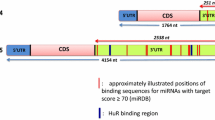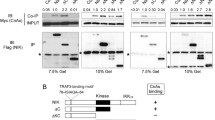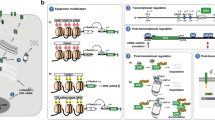Abstract
Tumour necrosis factor related apoptosis inducing ligand (TRAIL) binds to death receptor 4 (DR4) activating the apoptotic signalling pathway. DNA damaging agents (genotoxins) such as etoposide increase DR4 expression and when combined with TRAIL induce a synergistic apoptotic response. The mechanism for up-regulation of DR4 expression following genotoxin treatment is not well understood. Herein, we determined that transcription factor NF-κB plays a role in genotoxin induced DR4 expression. Increased expression of DR4 following etoposide treatment is blocked by inhibition of the NF-κB pathway. Moreover, expression of the p65 subunit of NF-κB is sufficient to increase DR4 protein levels. Indeed, knockdown of p65 by RNA interference blocked etoposide up-regulation of DR4. We further identified a functional NF-κB binding site located in the DR4 promoter. Mutation of this site abrogates the induction of luciferase activity after p65 over-expression. Furthermore, electromobility shift assays and chromatin immunoprecipitaton suggest that NF-κB binds to this site upon etoposide treatment. MEK kinase 1 (MEKK1) is a serine threonine kinase that is activated following etoposide treatment and activates NF-κB. Expression of the kinase inactive MEKK1 (MEKK1-KM) abrogates the up-regulation of DR4 after etoposide treatment. Taken together, NF-κB plays a role in up-regulation of DR4 following etoposide treatment.






Similar content being viewed by others
References
Walczak H, Miller RE, Ariail K et al (1999) Tumoricidal activity of tumor necrosis factor-related apoptosis-inducing ligand in vivo. Nat Med 5:157–163
Griffith TS, Chin WA, Jackson GC, Lynch DH, Kubin MZ (1998) Intracellular regulation of TRAIL-induced apoptosis in human melanoma cells. J Immunol 161:2833–2840
Gibson SB, Oyer R, Spalding AC, Anderson SM, Johnson GL (2000) Increased expression of death receptors 4 and 5 synergizes the apoptosis response to combined treatment with etoposide and TRAIL. Mol Cell Biol 20:205–212
Singh TR, Shankar S, Srivastava RK (2005) HDAC inhibitors enhance the apoptosis-inducing potential of TRAIL in breast carcinoma. Oncogene 24:4609–4623
Duiker EW, Mom CH, de Jong S et al (2006) The clinical trail of TRAIL. Eur J Cancer 42:2233–2240
Zhang L, Fang B (2005) Mechanisms of resistance to TRAIL-induced apoptosis in cancer. Cancer Gene Ther 12:228–237
Keane MM, Ettenberg SA, Nau MM, Russell EK, Lipkowitz S (1999) Chemotherapy augments TRAIL-induced apoptosis in breast cell lines. Cancer Res 59:734–741
Shetty S, Gladden JB, Henson ES et al (2002) Tumor necrosis factor-related apoptosis inducing ligand (TRAIL) up-regulates death receptor 5 (DR5) mediated by NFκB activation in epithelial derived cell lines. Apoptosis 7:413–420
Shetty S, Graham BA, Brown JG et al (2005) Transcription factor NF-κB differentially regulates death receptor 5 expression involving histone deacetylase 1. Mol Cell Biol 25:5404–5416
Yoshida T, Maeda A, Tani N, Sakai T (2001) Promoter structure and transcription initiation sites of the human death receptor 5/TRAIL-R2 gene. FEBS Lett 507:381–385
Liu X, Yue P, Khuri FR, Sun SY (2004) p53 Upregulates death receptor 4 expression through an intronic p53 binding site. Cancer Res 64:5078–5083
Ravi R, Bedi GC, Engstrom LW et al (2001) Regulation of death receptor expression and TRAIL/Apo2L-induced apoptosis by NF-κB. Nat Cell Biol 3:409–416
Chen X, Kandasamy K, Srivastava RK (2003) Differential roles of RelA (p65) and c-Rel subunits of nuclear factor κB in tumor necrosis factor-related apoptosis-inducing ligand signaling. Cancer Res 63:1059–1066
Mendoza FJ, Henson ES, Gibson SB (2005) MEKK1-induced apoptosis is mediated by Smac/Diablo release from the mitochondria. Biochem Biophys Res Commun 331:1089–1098
Bild AH, Mendoza FJ, Gibson EM et al (2002) MEKK1-induced apoptosis requires TRAIL death receptor activation and is inhibited by AKT/PKB through inhibition of MEKK1 cleavage. Oncogene 21:6649–6656
Gibson EM, Henson ES, Villanueva J, Gibson SB (2002) MEK kinase 1 induces mitochondrial permeability transition leading to apoptosis independent of cytochrome c release. J Biol Chem 277:10573–10580
Yujiri T, Fanger GR, Garrington TP, Schlesinger TK, Gibson S, Johnson GL (1999) MEK kinase 1 (MEKK1) transduces c-Jun NH2-terminal kinase activation in response to changes in the microtubule cytoskeleton. J Biol Chem 274:12605–12610
Gibson S, Widmann C, Johnson GL (1999) Differential involvement of MEK kinase 1 (MEKK1) in the induction of apoptosis in response to microtubule-targeted drugs versus DNA damaging agents. J Biol Chem 274:10916–10922
Widmann C, Gibson S, Johnson GL (1998) Caspase-dependent cleavage of signaling proteins during apoptosis. A turn-off mechanism for anti-apoptotic signals. J Biol Chem 273:7141–7147
Hirano M, Osada S, Aoki T et al (1996) MEK kinase is involved in tumor necrosis factor alpha-induced NF-κB activation and degradation of IκB-alpha. J Biol Chem 271:13234–13238
Lee FS, Peters RT, Dang LC, Maniatis T (1998) MEKK1 activates both IκB kinase alpha and IκB kinase beta. Proc Natl Acad Sci USA 95:9319–9324
David L (1998) Spector RDG, Leslie A. Leinwand. Culture and Biochemical analysis of Cells. Cold Spring Harbor Laboratory Press, New York
Spencer VA, Sun JM, Li L, Davie JR (2003) Chromatin immunoprecipitation: a tool for studying histone acetylation and transcription factor binding. Methods 31:67–75
Heinemeyer T, Wingender E, Reuter I et al (1998) Databases on transcriptional regulation: TRANSFAC, TRRD and COMPEL. Nucleic Acids Res 26:362–367
Pierce JW, Schoenleber R, Jesmok G et al (1997) Novel inhibitors of cytokine-induced IκBalpha phosphorylation and endothelial cell adhesion molecule expression show anti-inflammatory effects in vivo. J Biol Chem 272:21096–21103
Brockman JA, Scherer DC, McKinsey TA et al (1995) Coupling of a signal response domain in I κB alpha to multiple pathways for NF-κB activation. Mol Cell Biol 15:2809–2818
Pukac L, Kanakaraj P, Humphreys R et al (2005) HGS-ETR1, a fully human TRAIL-receptor 1 monoclonal antibody, induces cell death in multiple tumour types in vitro and in vivo. Br J Cancer 92:1430–1441
Vasilevskaya IA, O’Dwyer PJ (2005) 17-Allylamino-17-demethoxygeldanamycin overcomes TRAIL resistance in colon cancer cell lines. Biochem Pharmacol 70:580–589
Izeradjene K, Douglas L, Tillman DM, Delaney AB, Houghton JA (2005) Reactive oxygen species regulate caspase activation in tumor necrosis factor-related apoptosis-inducing ligand-resistant human colon carcinoma cell lines. Cancer Res 65:7436–7445
Bennett BL, Sasaki DT, Murray BW et al (2001) SP600125, an anthrapyrazolone inhibitor of Jun N-terminal kinase. Proc Natl Acad Sci USA 98:13681–13686
Sayers TJ, Murphy WJ (2006) Combining proteasome inhibition with TNF-related apoptosis-inducing ligand (Apo2L/TRAIL) for cancer therapy. Cancer Immunol Immunother 55:76–84
Guan B, Yue P, Lotan R, Sun SY (2002) Evidence that the human death receptor 4 is regulated by activator protein 1. Oncogene 21:3121–3129
Kucharczak J, Simmons MJ, Fan Y, Gelinas C (2003) To be, or not to be: NF-κB is the answer–role of Rel/NF-κB in the regulation of apoptosis. Oncogene 22:8961–8982
Dutta J, Fan Y, Gupta N, Fan G, Gelinas C (2006) Current insights into the regulation of programmed cell death by NF-κB. Oncogene 25:6800–6816
Widmann C, Gibson S, Jarpe MB, Johnson GL (1999) Mitogen-activated protein kinase: conservation of a three-kinase module from yeast to human. Physiol Rev 79:143–180
Xia Y, Makris C, Su B et al (2000) MEK kinase 1 is critically required for c-Jun N-terminal kinase activation by proinflammatory stimuli and growth factor-induced cell migration. Proc Natl Acad Sci USA 97:5243–5248
Xu S, Cobb MH (1997) MEKK1 binds directly to the c-Jun N-terminal kinases/stress-activated protein kinases. J Biol Chem 272:32056–32060
Nakano H, Shindo M, Sakon S et al (1998) Differential regulation of IκB kinase alpha and beta by two upstream kinases, NF-κB-inducing kinase and mitogen-activated protein kinase/ERK kinase kinase-1. Proc Natl Acad Sci USA 95:3537–3542
Nemoto S, DiDonato JA, Lin A (1998) Coordinate regulation of IκB kinases by mitogen-activated protein kinase kinase kinase 1 and NF-κB-inducing kinase. Mol Cell Biol 18:7336–7343
Hinz S, Trauzold A, Boenicke L et al (2000) Bcl-XL protects pancreatic adenocarcinoma cells against CD95- and TRAIL-receptor-mediated apoptosis. Oncogene 19:5477–5486
Fulda S, Kufer MU, Meyer E, van Valen F, Dockhorn-Dworniczak B, Debatin KM (2001) Sensitization for death receptor- or drug-induced apoptosis by re-expression of caspase-8 through demethylation or gene transfer. Oncogene 20:5865–5877
Eggert A, Grotzer MA, Zuzak TJ et al (2001) Resistance to tumor necrosis factor-related apoptosis-inducing ligand (TRAIL)-induced apoptosis in neuroblastoma cells correlates with a loss of caspase-8 expression. Cancer Res 61:1314–1319
Zhang L, Gu J, Lin T, Huang X, Roth JA, Fang B (2002) Mechanisms involved in development of resistance to adenovirus-mediated proapoptotic gene therapy in DLD1 human colon cancer cell line. Gene Ther 9:1262–1270
Kurbanov BM, Fecker LF, Geilen CC, Sterry W, Eberle J (2006) Resistance of melanoma cells to TRAIL does not result from upregulation of antiapoptotic proteins by NF-κB but is related to downregulation of initiator caspases and DR4. Oncogene
Kabore AF, Sun J, Hu X, McCrea K, Johnston JB, Gibson SB (2006) The TRAIL apoptotic pathway mediates proteasome inhibitor induced apoptosis in primary chronic lymphocytic leukemia cells. Apoptosis 11:1175–1193
Acknowledgements
We would like to thank Dr. Shi-Yong Sun (Emory University) for the kind gift of DR4 (−1773/+63) and DR4 (−586/+63) luciferase plasmid. Furthermore we would like to thank Human Genome Science for the kind gift of Matatumumab monoclonal antibody. The work is supported by a grant from Canadian Institutes of Health Research (MOP 68872). Mr. Mendoza is supported by a Natural Sciences and Engineering Research Council of Canada doctoral post graduate scholarship.
Author information
Authors and Affiliations
Corresponding author
Rights and permissions
About this article
Cite this article
Mendoza, F.J., Ishdorj, G., Hu, X. et al. Death receptor-4 (DR4) expression is regulated by transcription factor NF-κB in response to etoposide treatment. Apoptosis 13, 756–770 (2008). https://doi.org/10.1007/s10495-008-0210-0
Published:
Issue Date:
DOI: https://doi.org/10.1007/s10495-008-0210-0




